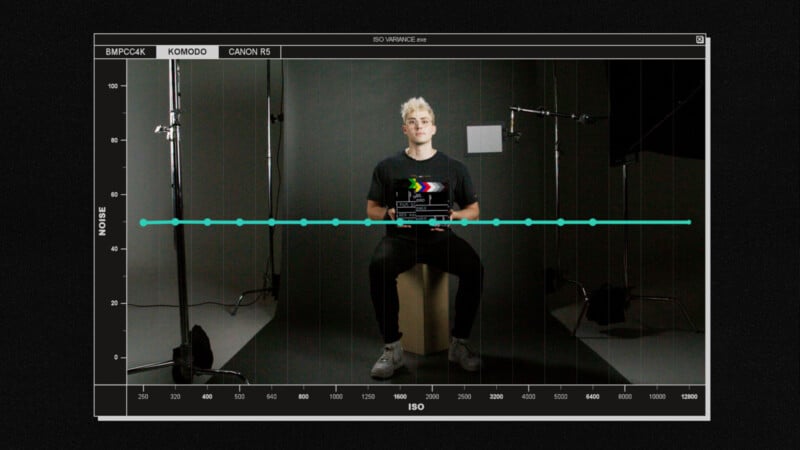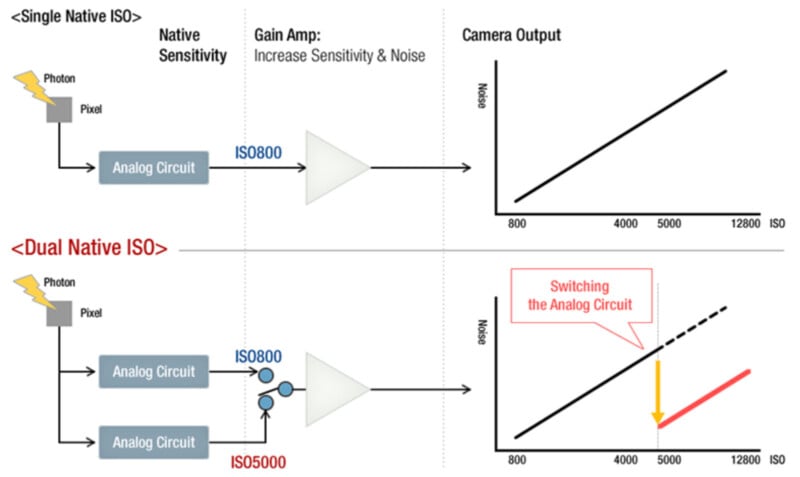A Deep Dive into ISO: How Variance and Dual Native ISO Affect Noise
“This is the ISO wheel on your camera, and sometimes, it does nothing,” says Syrp Lab in its newest video. Syrp Lab takes a deep dive into ISO, explaining what it is, discussing Dual Native ISO and ISO variance, and providing the information people need to shoot the cleanest possible video.
How Does ISO Work?
The first step along the journey to cleaner video is understanding what ISO is and what it does.
“ISO is one of the first things you learn about when starting with video, and you probably know that if you crank ISO up, you make your camera more sensitive to light,” Syrp Lab explains. This makes everything brighter, but it also makes video noisier.
![]()
However, that is an oversimplification because with some cameras, increasing ISO doesn’t necessarily mean increasing the noise in video.
When More Light is Needed, Crank the ISO
When shooting video — or photos, although Syrp Lab is focused on video applications — there are numerous ways to make the footage look brighter. The user can adjust the shutter speed or aperture, for example. However, users can also increase the camera’s ISO, often described as making the image sensor more light-sensitive.
![]()
When light travels through a lens and hits an image sensor, the sensor measures the intensity of light as voltage. The voltage is converted into a digital value using an analog-to-digital converter. When the values are too low — the video looks too dark — the sensor can’t physically change to have larger photo sites. There are some software tricks that some cameras use to combine pixels into sites that behave like larger photo sites, but that still doesn’t actually change the image sensor.
Different Cameras Handle ISO in Different Ways
Cameras have a few options to achieve more signal and make video appear brighter. Syrp Lab looks at three cameras, a RED Komodo 6K that controls ISO entirely digitally, the Canon EOS R5 that “deals with ISO electrically,” and the Blackmagic Pocket Cine camera that has Dual Native ISO.



To test how each camera handles ISO and noise, the Syrp Lab team correctly exposed each camera at ISO 12,800 by controlling light power. They then decreased ISO without adjusting lights and brought the footage back up to the initial exposure during post-processing. For photographers, this is like intentionally underexposing a scene by -4 EV and then adding +4 EV in Adobe Camera Raw. It’s the same basic idea here.
The three tested cameras also perform very differently in this test. Why? Syrp Lab points out that these cameras operate with different approaches to ISO. The RED camera is ISO invariant, the Canon R5 is ISO variant, and the Dual Native ISO Blackmagic camera uses a “top secret” method.
In the RED Komodo’s case, “ISO invariant” means that changes to “ISO” are performed digitally and not at the sensor level. The footage is made to look brighter by changing the RGB values using software. ISO settings on the camera are saved in file metadata and then applied in post. For example, if a user shoots at ISO 6400, this is just footage shot at the camera’s base ISO with a data tag that tells video editing software to boost the footage to that exposure value. The sensor didn’t do anything differently because the ISO was changed.
For an ISO variant camera like the Canon R5, the camera takes the voltage from its image sensor and increases it using an amplifier. This increases the signal at an electrical rather than a software level, resulting in more noise at higher ISO settings. It also means that there is a difference between boosting ISO on the camera and achieving the same exposure in software during post-processing.
![]()
Dual Native ISO cameras are like ISO invariant cameras but have two analog circuits on the sensor for different lighting situations. The steps in between are handled digitally. Panasonic uses Dual Native ISO in some of its cameras and describes the technology as follows:
Dual Native ISO technology is a unique way of exploiting a camera’s sensor information to extend its dynamic range and reduce the level of signal noise that is produced. The sensor will therefore be able to read two native ISOs on the sensor instead of one.

How ISO Handling Affects Video Quality
What type of ISO handling technology a camera uses affects the quality of its photos and videos at different ISO settings.
“For an ISO invariant camera, the signal is boosted digitally, meaning that the amount of noise is equal across all ISOs,” says Syrp Lab. There isn’t more noise at the sensor level because the sensor isn’t becoming more sensitive to light, but the noise becomes more visible as the footage is brightened.
A Dual Native ISO camera has two native ISO settings. Any ISO setting higher than the base native ISO and lower than the second native ISO will be digitally boosted. The result is that the higher of the two native ISO settings can actually display less noise than a digitally-boosted lower ISO. For example, the Blackmagic camera’s second native ISO is 1250, which shows less noise than ISO 1000 because ISO 1000 is the lower base ISO setting with significant digital boosting applied.
![]()
An ISO variant camera like the Canon R5 has different steps where the sensor appears to become physically more sensitive to light. In-between steps utilize digital processing to increase brightness. This means noise doesn’t increase linearly but has a stair-stepping change as ISO increases.
What Should People Do?
“In general, on all cameras, you want to shoot as bright as possible without clipping and then bring your exposure, or gain, down in post. This pushes your noise floor down, ensuring you have the best performance, and you’ll often hear it called ‘expose to the right.’ This should be done through your lighting, and if you have to, your aperture and shutter speed, so you can shoot at your camera’s native ISO,” Syrp Lab recommends.
When users have no option but to change their ISO to adjust to the prevailing lighting, the recommended workflow depends on how a camera handles ISO.
For an ISO-invariant camera or when shooting compressed footage, users should increase their ISO until the footage is correctly exposed in the camera. Increasing the brightness in post with an ISO-invariant camera will result in noisier footage.
When shooting on a Dual Native ISO camera, users are better off shooting at the second native ISO than shooting underexposed at the lower base ISO setting. Ultimately, ensuring that footage looks good in the camera is the best bet.
On a camera with an ISO-invariant sensor, adjusting the ISO on the camera has no impact on the camera’s raw footage. It’s just an in-camera indicator of how software will handle the footage during post-processing. The changes in the camera are just a preview.
![]()
More From Syrp Lab
Syrp Lab produces a lot of content to help videographers, including some that PetaPixel has featured, including a look at what makes lenses appear more “cinematic,” comparing different types of image stabilization, and tips for shooting appetizing food footage.
Image credits: Syrp Lab